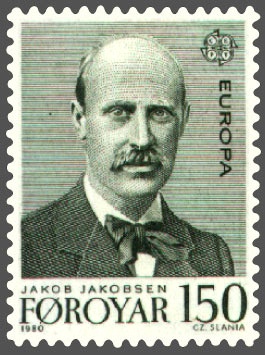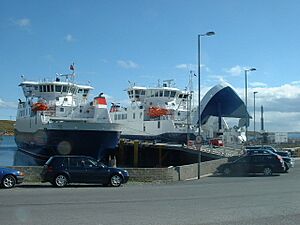Norn language facts for kids
Quick facts for kids Norn |
||||
|---|---|---|---|---|
| norn | ||||
| Native to | Scotland | |||
| Region | Northern Isles and Caithness | |||
| Extinct | 1850, with the death of Walter Sutherland | |||
| Language family |
Indo-European
|
|||
| Early forms: |
Old Norse
|
|||
| Writing system |
|
|||
| Linguist List | nrn | |||
| Linguasphere | 52-AAA-ac | |||
|
||||
Norn was an old language spoken in the Northern Isles of Scotland. These islands are Orkney and Shetland, located north of mainland Scotland. Norn was also spoken in Caithness, a part of the Scottish mainland. It was a North Germanic language, similar to Norwegian, Icelandic, and Faroese.
Norn slowly disappeared after Orkney and Shetland became part of Scotland in 1468–69. It was replaced by the Scots language. People believe Norn became extinct around 1850. The last known person to speak Norn was Walter Sutherland. Some people claim it might have been spoken a little longer, even into the early 1900s.
Contents
History of Norn

Norse people, who spoke an early form of Norn, first settled in the Northern Isles. This probably happened in the early 800s. Many settlers came from the west coast of Norway. They arrived in large numbers, similar to those who settled in Iceland and the Faroe Islands. The names of places in Shetland are like those in northwest Norway. Also, some Norn words suggest links to southern Norwegian areas.
Orkney and Shetland officially became part of Scotland in 1468 and 1469. This is when the Norn language really started to be replaced by Scots. However, Norn began to decline in Orkney even earlier. This was around 1379, when the Earldom of Orkney went to Henry Sinclair. By the early 1400s, Scots was seen as a more important language in Orkney.
In Shetland, the change started later. But by the end of the 1400s, people in both island groups spoke two languages (they were bilingual). Norn did not disappear quickly. Most people in Orkney and Shetland probably spoke Norn as their main language. This continued until the late 1500s in Orkney and the mid-1600s in Shetland. One of the last documents written in Norn was for a property in Shetland in 1597.
How Norn Disappeared
No one knows exactly when Norn completely died out. Records from the 1600s and 1700s show Norn was fading. These records often called it "Norse" or "Danish." They also said Norn was stronger in Shetland than in Orkney.
In 1670, a report said only "three or four parishes" in Orkney still spoke "Noords." They mostly spoke it at home. In 1701, some people in Shetland still spoke only Norn. There were more Norn speakers in Shetland than in Orkney. By 1703, most Shetlanders spoke a Scots dialect. But "many among them retain the ancient Danish Language." In 1750, James Mackenzie wrote that Norn was not fully gone. Old people still spoke it among themselves.
The last reports of Norn speakers are from the 1800s. Some even claim a very small use into the early 1900s. But it is more likely the language was dying out in the late 1700s. The isolated islands of Foula and Unst are thought to be the last places Norn was spoken in Shetland. People there could "repeat sentences" in Norn as late as 1893. These were probably parts of old songs or poems. Walter Sutherland from Unst, who died around 1850, is often called the last native speaker of Norn.
Even though the language died, many Norn words still exist today. They are found in place-names. They also describe plants, animals, weather, moods, and fishing terms.
Norn was also spoken in Caithness, but it likely died out there by the 1400s. Not much is known about "Caithness Norn." Very few written Norn texts survive. These include a version of the Lord's Prayer and a ballad called "Hildina".
How Norn is Classified
Norn is an Indo-European language. It belongs to the North Germanic group of Germanic languages. It is part of the West Scandinavian group. This group also includes Faroese, Icelandic, and Norwegian. This separates it from East Scandinavian languages like Swedish and Danish.
Today, languages are also grouped by how well speakers can understand each other. This divides them into Insular Scandinavian (island languages) and Mainland Scandinavian. Norwegian, Danish, and Swedish have changed a lot over time. This makes them different from Faroese and Icelandic.
Norn is generally thought to have been quite similar to Faroese. They shared many sounds and grammar rules. People speaking Norn and Faroese might have understood each other. So, Norn is considered an Insular Scandinavian language.
Norn is different from the Shetland dialect spoken today. That dialect came from Middle English.
Sounds and Grammar
It's hard to know exactly how Norn sounded. This is because there are not many written examples. But we can guess some things from the few texts we have. Norn shared many sounds with dialects from southwest Norway. For example, sounds like 'p', 't', 'k' often became 'b', 'd', 'g' after vowels. Also, 'th' sounds (like in "thing" or "that") often became 't' or 'd'.
Norn grammar was very similar to other Scandinavian languages. It had two numbers (singular and plural). It had three genders (like masculine, feminine, neuter). It also had four cases (different forms of words depending on their job in a sentence). Verbs also changed for present and past tense. Like other North Germanic languages, Norn added a suffix to the end of a word to show it was definite. For example, man(n) meant "man," and mannen meant "the man."
Examples of Norn

Here are versions of the Lord's Prayer in Norn, Old Norse, and other Scandinavian languages:
- Orkney Norn:
- Fa vor i ir i chimrie, / Helleur ir i nam thite,
- gilla cosdum thite cumma, / veya thine mota vara gort
- o yurn sinna gort i chimrie, / ga vus da on da dalight brow vora
- Firgive vus sinna vora / sin vee Firgive sindara mutha vus,
- lyv vus ye i tumtation, / min delivera vus fro olt ilt.
- Amen.
- Shetland Norn:
- Fy vor or er i Chimeri. / Halaght vara nam dit.
- La Konungdum din cumma. / La vill din vera guerde
- i vrildin sindaeri chimeri. / Gav vus dagh u dagloght brau.
- Forgive sindorwara / sin vi forgiva gem ao sinda gainst wus.
- Lia wus ikè o vera tempa, / but delivra wus fro adlu idlu.
- [For do i ir Kongungdum, u puri, u glori.] Amen.
- Faþer vár es ert í himenríki, / verði nafn þitt hæilagt
- Til kome ríke þitt, / værði vili þin
- sva a iarðu sem í himnum. / Gef oss í dag brauð vort dagligt
- Ok fyr gefþu oss synþer órar, / sem vér fyr gefom þeim er viþ oss hafa misgert
- Leiðd oss eigi í freistni, / heldr leys þv oss frá ollu illu.
- Amen.
- Faðir vár, tú sum ert í himlinum. / Heilagt verði navnið títt.
- Komi ríkið títt. / Verði vilji tín,
- so sum á himli, so á jørð. / Gev okkum í dag okkara dagliga breyð.
- Fyrigev okkum syndir okkara, / so sum vit eisini fyrigeva teimum, ið móti okkum synda.
- Leið okkum ikki í freistingar, / men frels okkum frá tí illa.
- [Tí at títt er ríkið, valdið og heiðurin um aldur og allar ævir.] Amen.
- Faðir vor, þú sem ert á himnum. / Helgist þitt nafn,
- til komi þitt ríki, / verði þinn vilji,
- svo á jörðu sem á himni. / Gef oss í dag vort daglegt brauð.
- Fyrirgef oss vorar skuldir, / svo sem vér og fyrirgefum vorum skuldunautum.
- Og eigi leið þú oss í freistni, / heldur frelsa oss frá illu.
- [Því að þitt er ríkið, mátturinn og dýrðin að eilífu.] Amen.
- Fader vår, du som er i himmelen! / Lat namnet ditt helgast;
- lat riket ditt koma; / lat viljen din råda på jordi som i himmelen;
- gjev oss i dag vårt daglege brød; / og forlat oss vår skuld, som me òg forlet våre skuldmenn;
- og før oss ikkje ut i freisting; / men frels oss frå det vonde.
- For riket er ditt, og magti og æra i all æva! Amen
- Vår fader, du som är i himlen / låt ditt namn bli helgat.
- Låt ditt rike komma / låt din vilja ske på jorden så som i himlen.
- Ge oss i dag vårt bröd för dagen som kommer / och förlåt oss våra skulder,
- liksom vi har förlåtit dem som står i skuld till oss,
- och utsätt oss inte för prövning / utan rädda oss från det onda.
- Ty riket är ditt, och makt och ära för evigt! Amen.
A Shetland "guddick" (riddle) in Norn:
Shetland Norn (Jakob Jakobsen)
|
Faroese
|
Icelandic
|
Orcadian dialect of Scots (not Norn)
|
English translation
|
Traditional version from England
|
The answer to this riddle is a cow! Four teats hang, four legs walk, two horns and two ears stand up, two eyes show the way to the field, and one tail comes shaking behind.
Norn Today
Today, Norn or Old Norse is mostly used for special events in Shetland and Orkney. For example, Shetland's motto is Með lögum skal land byggja. This means "with law shall land be built." It is the same motto used by the Icelandic police.
Another example is the names of ferries. NorthLink Ferries has ships named MV Hamnavoe (an old name for Stromness). They also have MV Hjaltland (Shetland) and MV Hrossey ("Horse Island," an old name for Mainland, Orkney). The Yell Sound Ferry uses two ferries named Daggri (Norse for "dawn") and Dagalien (Norse for "dusk").
Norn words are still used to describe the colors and patterns of native sheep. These are the Shetland and North Ronaldsay sheep breeds. Icelandic sheep have similar words for their color variations.
Some people are working to create a modern form of Norn. They call it Nynorn ("New Norn"). They base it on old records and Norse language studies.
In 2022, a singer named Inge Thompson sang a song in Norn. This was at a concert celebrating Shetland's 550th anniversary of becoming Scottish. In 2023, singer Siobhan Wilson also released a song with the Norn language.
See also
- Udal law, the old Norse law system of the Northern Isles.



